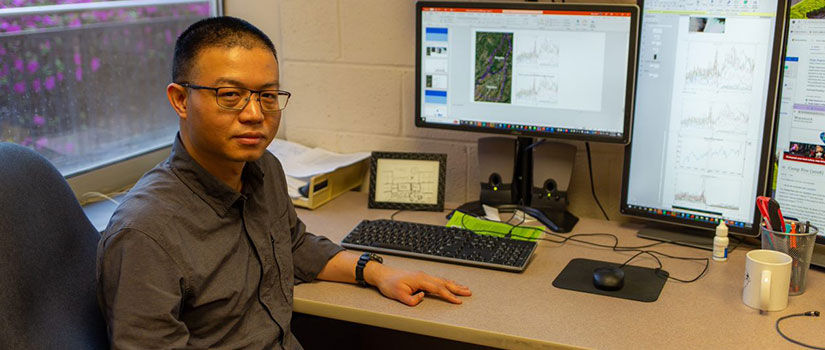Growing up in southern China, Huan Ning admired the pilots he saw on billboards around his city, and he dreamed of following in their footsteps. However, a need for glasses foiled his plans of soaring through the clouds.
But Ning found another way to get a similar view. After earning an undergraduate degree from Wuhan University, he worked as a geographic data engineer for over a decade. Taking a satellite's sky-high view, he collected, processed and managed geographic data to support systems that rely on location-based data, like navigation applications and emergency services.
As the technology advanced, so did his field, and Ning sought to learn how to incorporate artificial intelligence into his work with geographic data.
Now a geography Ph.D. student at the University of South Carolina, Ning is pushing the boundaries of Geographic information science (GIScience) by using emergent artificial intelligence technology to study urban problems like neighborhood accessibility, flooding risk and the spread of illness.
By integrating GIScience with remote sensing and machine learning, Ning has developed novel approaches that combine computational, social and natural sciences. His innovative research has earned him recognition as a Breakthrough Graduate Scholar and SPARC Graduate Research Grant recipient.
“My objective is to liberate people from laborious work so they can leave the computer screen and do more meaningful work.”
— Huan Ning
Helpful AI applications
In his current research, Ning is using sidewalk data from street view images to create an inventory of accessible neighborhoods. He uses AI to analyze the images and measure the width and slope of sidewalks, based on his parameters for spaces likely to be accessible.
By automating the collection of data — a process called extraction — Ning can help improve the efficiency and accuracy of analysis.
Ning says AI has vastly improved his work efficiency after years of mapping such data by hand.
“I needed to gather data in a better way,” he says. “I was trying to finish the work with very limited human resources, but now I have better tools and technology.”
AI can quickly process data and create visualizations, including graphs and maps that indicate where sidewalks fit the specifications for accessibility and where they do not.
The improved method may help decision makers and urban planners better understand and manage geographic data.
Accessibility isn’t the only area that may benefit.
Ning has also applied this approach to estimate if homes are at risk of flooding. Using a vertical measuring method in street view images, Ning instructs the AI to estimate the first-floor elevation of residential houses.
“If I know the water depth of a flood and the elevation of the first floor, I can find out if your house is at flooding risk,” Ning says. What has traditionally required surveying specialists, Ning can now do quickly and inexpensively from his computer.
Big data as a tool
Another way Ning uses AI analysis is in collecting and using large sets of geographic information, known as “big data.”
This data is generated by satellite imagery, GPS signals and social media, to name a few. By studying these datasets, GIScience can support decision making in fields such as urban planning, disaster management, environmental monitoring and business intelligence.
Ning used this data and AI to create a simulation which mapped COVID-19 spreading factors. Comparing data on smartphone mobility with the spread of the illness, he found that COVID spreads most at the neighborhood level, with restaurants and schools being additional hot spots for spread.
This data-driven discovery can help public health officials prepare to predict future pandemics and respond with effective policy.
As he continues to innovate in the field of GIScience, Ning says his work has the potential to make our world more accessible, more resilient and more equitable.
He says a big challenge with that goal is keeping up with ever-advancing technology.
“New technologies are developing at a lightning pace,” Ning says.
“My objective is to liberate people from laborious work so they can leave the computer screen and do more meaningful work.”
